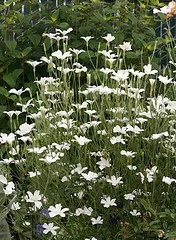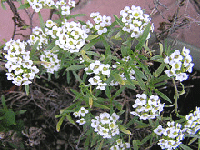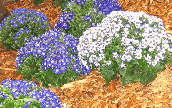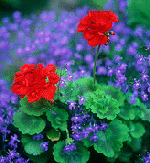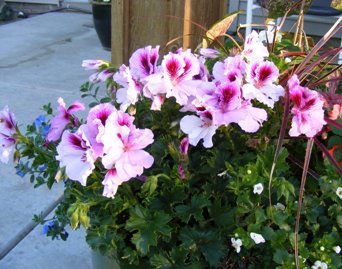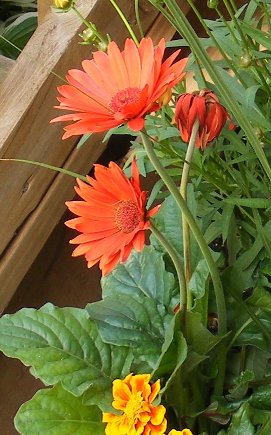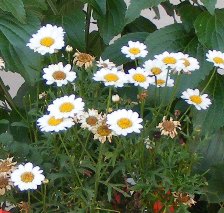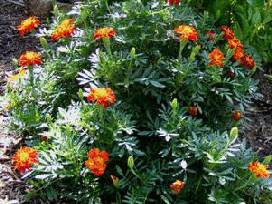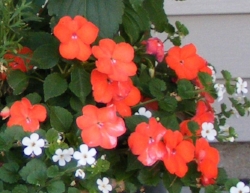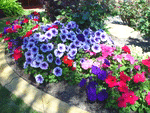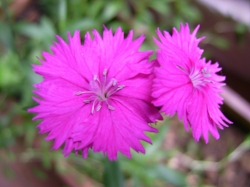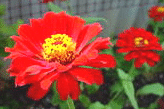Best Performing Annuals for your Gardens & Containers
Although not comprehensive, this selection of top-performing annuals is a helpful starting point for finding easy-to-grow plants that thrive in adverse conditions or produce stunning and unique flowers.
Any issues associated with a particular plant are mentioned, and it's up to you to determine if it's a concern for your garden.
Why not try something different in your garden this year?
Agrostemma
'Ocean Pearl', also called Corn Cockel, is a tall annual plant with beautiful five-petaled white flowers, which make it an excellent choice for cut flowers. Other variations of this plant are available in striking shades of pink and purple.
It is a hardy plant that can grow well even in poor soil, but it can be invasive due to its abundant self-seeding. To control its self-seeding, it's recommended to remove spent blooms, which also promotes additional blooming. Agrostemma is a fantastic cut flower that thrives in full sun and can grow up to 24-36 inches in height.
Alyssum
This low-growing edging plant forms a tidy mound and produces abundant blooms from spring until frost. The fragrant flowers can be white, blue, or blue-violet and thrive in sunny locations. Additionally, this plant may self-seed, providing a helping hand for next year's edging.
Growing only a few inches tall but spreading up to a foot, it can tolerate dry and poor conditions but prefers good soil and moisture for optimal growth. Seeds are readily available, and established plants can be found in most garden stores.
Anagallis monelli (or pimpernel)
'Skylover' is a unique and uncommon plant with vibrant, true blue flowers that have pink centers and five petals. It's an excellent choice for garden beds, borders, and planters, blooming from late spring until the first frost.
This plant has a slight trailing habit and thrives in full sun, requiring regular fertilizing and moisture to perform at its best. However, it can tolerate brief periods of drought.
Bacopa
'Snowstorm' is a white-flowered plant that is heat-tolerant and has deep green foliage, making it an attractive trailing addition to planters, baskets, and window boxes. The plant produces numerous small, bright, and cheerful five-petaled white flowers along its stems.
'Snowstorm' can grow well in both sun and shade but requires frequent watering when grown in full sun. Regular fertilizing is also recommended. Note that Bacopa is an herb known for its medicinal benefits and is a perennial plant in the southern regions.
Cannas
This tropical plant is an annual in the North and Midwest regions, requiring full sun to thrive. Its tall and elegant flowers make a striking statement, even when grown as a single plant.
It can grow up to 6 feet tall and forms a large clump. This plant prefers a rich, well-drained soil. While the root clumps can be stored over winter, this task can be challenging.
Cineraria
These plants are compact and mounded, covered in stunning flowers. While they are a perennial in zones 8 and 9, blooming in winter, they can also be grown as a houseplant.
In Midwest gardens, however, they are grown as annuals and prefer full sun. These plants can be challenging to find, so if you come across them, it's recommended to pick one up. Their beauty is worth the effort of trying to save them indoors over the winter.
Caladium and Coleus
With an abundance of new coleus varieties, there are options for any spot that needs a colorful accent with varying colors, sizes, and textures. These plants come in interesting leaf shapes and patterns, with speckles and spots, and colors ranging from chartreuse to violet.
They are perfect for brightening shady spots or adding color and texture to shaded pots. While coleus is known for its shade tolerance, many varieties can also thrive in part to full sun. However, they require consistent watering and may dry out quickly during sustained or high winds. To maintain a nice mounded shape, it's recommended to pinch them back.
Cosmos bipinnatus 'Picotee'
'Picotee' is one of the many fast-growing and prolific cosmos varieties that offer 80 days of blooming with beautiful white flowers outlined in red. Most cosmos plants self-seed readily, grow quickly, and produce 3-4 inch double daisy-like blooms in pink, red, white, and lavender.
These plants prefer full sun but can tolerate light shade, growing to heights of 4 to 6 feet by the end of the season. They are easy to grow from seed and require minimal effort.
Dahlia
Dahlias are available in hundreds of varieties, ranging from 1 to 5 feet tall, but the dinner-plate dahlia with its enormous blooms is a showstopper. However, dahlias require more preparation and care than the average annual, especially if you intend to store the roots for the following year.
For optimal results, the soil must be fertile, and organic matter should be added annually. The soil should also be moist but well-drained, and good air circulation is essential, so avoid crowding the plants. Dwarf varieties should be planted 8 inches apart, while taller varieties should be spaced up to 18 inches apart. The eye of the tuber (growth bud on the thick root) should be planted 2 to 3 inches below the surface.
If your dahlia was in a container, plant it at the same depth as it was in the pot. Dahlias can be grown from seed, with germination occurring in 5 to 14 days. To start them indoors, begin 4 to 6 weeks before the anticipated 70-degree weather.
Evolvulus glomeratus
The popular variety of this plant is called ‘Blue Daze,’ but you may also come across ‘Hawaiian Blue Eyes.’ While it's a perennial in zones 8-11, it can also be overwintered indoors. In the Midwest and northern regions, it makes for a fantastic full-sun annual that spills out of pots and window boxes. If you prefer a bushier plant, you can periodically pinch off the stems.
With its rare true-blue flowers and white eyes, these vivid little buttons add a beautiful pop of color to any space. 'Blue Daze' blooms continuously and profusely, but each flower lasts only a day (although with so many blooms, you might not notice!).
The flowers open in the morning and close in the afternoon, but they tend to stay open later in the day during the early part of the season or on sunny days. However, they may close on heavily overcast days.
To care for this plant, water it thoroughly but let the soil dry out somewhat between waterings. Don't let the soil stay dry for too long, or the plant may wilt. Evolvulus is pretty hardy and may tolerate light frosts.
Geranium (Pelargoniums, Zonal)
Geraniums are a popular choice for good reason. They thrive in moderately rich soil and can be used in a variety of ways, such as in formal beds, baskets, or tucked in a perennial garden for a pop of color in front of evergreen shrubs.
To encourage steady blooming, it's recommended to deadhead the spent blooms regularly and fertilize them frequently (or mix in a slow-release fertilizer during planting). Planting geraniums in full sun will yield the best results.
Geranium (Pelargoniums, Regal)
Regal Geraniums, including the Martha Washington variety, provide an array of color options that are not found in zonal geraniums. Many of these geraniums are bi-colored with vivid colors that create striking contrasts. They produce an abundance of clusters of two or three flowers with lush, dense foliage.
To encourage the best blooming, it's recommended to water the geraniums well, then allow the soil to dry out completely. These plants also benefit from regular fertilization every four weeks, and removing spent blooms will encourage more flowering. Geraniums thrive in hot and dry conditions, which help produce the best blooms.
Gerbera Daisy
Gerbera, also known as Transvaal Daisies, produce long-lasting blooms that can reach up to 4-5 inches in diameter and continue for at least six weeks. These plants have large green leaves that form a mound.
For optimal blooming, plant Gerbera in full sun, but if the heat is extreme, some afternoon shade may benefit the plant. They prefer well-drained soil with even moisture, but can tolerate some drying out. Gerberas thrive in cooler temperatures and may continue blooming until frost in ideal conditions.
When selecting plants, look for ones with several buds ready to bloom. Pay attention to the stem length of the blooms, as short-stemmed plants are likely to continue producing short stems. For container planting, longer stems may be preferred.
Impatiens
Impatiens are a must-have for adding a bright spot to even heavily shaded areas. They thrive in morning sun and can handle a bit more sun if you ensure they don't dry out. Even in heavy shade, they produce some bright blooms, but the plants will remain smaller and not bloom as heavily. Depending on the amount of sun they receive, Impatiens can reach 8 to 24 inches in height and spread 10 to 15 inches wide.
There are numerous color variations available, including pinks, reds, oranges, and white. These plants can be planted in masses, in pots or baskets, or tucked in here and there. However, they will wilt and drop their petals in too much sun, so constant watering is necessary.
It's best to avoid the hot afternoon sun, particularly if they are receiving more than half a day of sun. Mulching heavily will help retain soil moisture. 'New Guinea' impatiens are larger, sturdier, and tolerate more sun than traditional impatiens.
Licorice (Helichrysum)
Helichrysum is a non-flowering annual that adds a fabulous touch to hanging baskets or pots. The trailing soft silvery-green branches pair beautifully with bright ivy geraniums or verbena.
Limelight is a lime-green variety that is particularly eye-catching. Although Helichrysum is drought-tolerant, other plants that you pair it with may not be, so be mindful of their watering needs.
Marguerite Daisy (Argyranthemum frutescens) - formerly Chrysanthemum frutescens
The plant commonly referred to as Paris Daisy or Cobbitty Daisy produces bright and airy 2 1/2” blooms in white, pink, or yellow, which appear to float atop tall stems. Its deep-cut leaves are dark green and release an aromatic scent when pinched. The blooms continue throughout the summer, but may slow down in extreme heat. Deadheading when blooms brown will encourage heavier blooming.
This plant can grow up to 2 or 3 feet tall and wide, making it a beautiful addition to a border planting or as a container filler. It prefers full sun but benefits from afternoon shade in hot climates. Fertilizing every few weeks will help maintain its health and vibrancy.
Marigold
Marigolds offer 80-90 days of creamy yellow, yellow, or yellow-orange flowers and thrive in full sun. They can tolerate heat and neglect and have rich green foliage that forms a neat mound. This makes them perfect for edging plants, tucking in among vegetable plants, or in container plantings.
Marigolds are easy to grow from seed and there are many new hybrids available with different bloom looks and a range of colors.
Million Bells Petunia (Calibrachoa)
Million Bells, closely related to the petunia, is an excellent trailing plant that blooms profusely, much like Superbells. Its small petunia-like blooms make it ideal for spilling out of small pots or filling a small open space.
When grown in the ground, the trailing plant will form a dense mat covered with blooms in a variety of colors, including red, pink, blue, violet, yellow, orange, bronze, and white. Million Bells prefer loose, well-drained, enriched soil or potting soil and do best in full sun but will tolerate some shade.
They require minimal care, won't deteriorate as the summer wears on, and do not require deadheading. These plants tolerate neglect but do not like to be overwatered. Superbells produce slightly larger blooms and a more sprawling plant than Million Bells.
Morning Glory (Ipomoea)
This delicate vine produces flowers resembling nasturtiums. The blooms on older varieties are open from dawn until mid-morning, but newer varieties hold their blooms open for most of the day. These vines grow very quickly and can reach 10 feet or more.
For best blooming, plant them in average soil as too rich of soil can cause the plant to put more energy into foliage and seed production. This self-seeder should reproduce each year and the blooms last for 70 days.
New Guinea Impatiens
While New Guinea Impatiens can tolerate more sun than traditional impatiens, they still prefer partial shade, especially during hot afternoons. Like impatiens, New Guinea Impatiens do not tolerate drought, so ensure that they receive enough water.
The foliage of this plant comes in deep rich green, purple green, or variegated. Although New Guinea Impatiens were introduced to U.S. gardeners in 1972, they have become popular quickly for container gardens and hanging baskets due to their neat, mounded form. They are also great as bedding plants.
Petunias
There are many new hybrids of petunias available, making this old favorite new again. They bloom profusely all summer and come in a range of sizes, from petite to sprawling. Although they are generally easy to care for, they look best with regular deadheading. For fuller plants, it is recommended to pinch most or all of the stems back about halfway within the first few weeks of planting. If they become too leggy, pinch a few stems back again.
Tidal Wave is a great option for an upright plant, while Easy Wave is best for more mounded and compact plants. Most of the Wave petunias are ideal for hanging baskets, spilling out of pots, or tumbling down a hilly landscape.
If you can find them, the old-fashioned Supercascade petunia is unbeatable for baskets. For complete information on the many varieties of petunias, consult a guide on selecting and growing petunias.
Pinks Annual Dianthus
Pinks, commonly known as a perennial, can also be found as annuals in colder regions. China Pinks (Dianthus chinensis) and Sweet William (Dianthus barbatus) are two annual varieties that thrive in cooler climates. They prefer full sun to light shade, but need some afternoon shade. Ensure well-drained and enriched soil, and avoid overwatering, while maintaining moisture.
Deadheading helps in reblooming, and they will flower from May to October. They also serve as great cut flowers due to their height. The name "pinked" comes from the edge of their petals, which are often jagged. The annual pinks are very frost-resistant.
Purple Fountain Grass (Penniseturm setaceum 'Rubrum')
Purple Fountain Grass is a fast-growing grass that features arching plumes with green-burgundy foliage, making it a perfect centerpiece for large pots. When surrounded by colorful annuals and vines, it creates a stunning "potscape". 'Red Riding Hood' is a smaller variety, reaching a height of 20-30 inches.
Although it is a perennial in southern climates, Purple Fountain Grass is an annual in colder climates.
Sweet Potato Vine: (Ipomoea batatus)
The 'Margarita' or 'Terrace Lime' cultivar features large heart-shaped leaves in a bright lime green color that adds a pop of color to containers and baskets placed in lightly shaded areas.
On the other hand, 'Blackie' has textured leaves that are a rich shade of purple-red. This vine is a fast grower, so ensure that it has enough space to trail or prune it regularly.
Tickseed (Coreopsis tinctoria)
Although perennial coreopsis is a common sight in the Midwest and North, the tinctoria species is an annual. Thanks to crossbreeding, a greater variety of colors is available in both annual and perennial varieties.
While yellow and yellow-orange are the most common colors, the new breeds come in a wide range of colors and striking bi-colors. One such example is the ‘Jive’ from the Coreopsis Big Bang series, with white petals, burgundy centers, and an orange eye.
Annual coreopsis plants produce long-lasting, daisy-like flowers in abundance. They are easy to grow from seed in full sun and average, well-drained soil.
Zinnias
With their tall and sturdy stems, these annuals with daisy-like blooms are resilient to neglect and can withstand hot and dry conditions. They thrive in poor soil and do not require deadheading. In fact, cutting the blooms encourages even more flowers.
Taller varieties may need support in windy areas, but they are perfect for creating beautiful bouquets. They can be easily grown from seed or bought as bedding plants. Zinnia 'Mexicana' is a self-sower.
